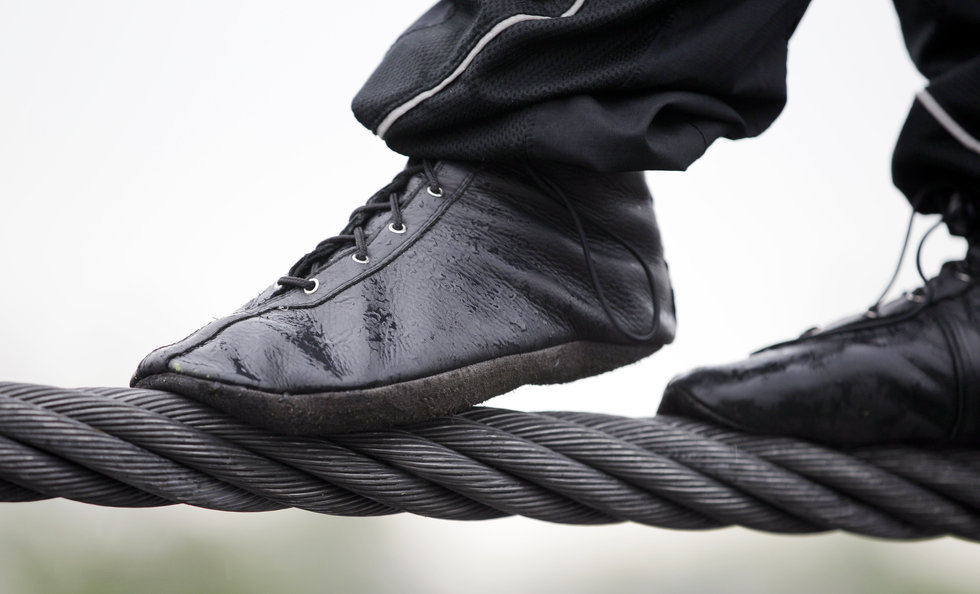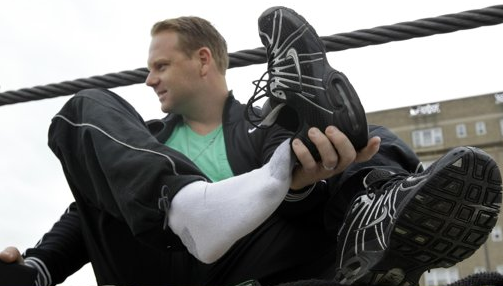
by Bill Katovsky.
I keep a close watch on this heart of mine
I keep my eyes wide open all the time
I keep the ends out for the tie that binds
Because you’re mine, I walk the line
— Johnny Cash, “I Walk The Line”
On Friday night before a crowd of a 100,000 neck-craning Canadians and millions of television viewers, Nik Wallenda, 33, became the first man to walk over the Niagara Falls Gorge in 116 years. About a dozen other tightrope artists have crossed the Niagara Gorge downstream, dating to Jean Francois Gravelet, aka The Great Blondin, in 1859.
Wallenda’s high-wire walk took him directly over the precipice at Niagara Falls and 190 feet above the raging waters below. ABC, which televised the event, demanded that Wallenda be secured at all times by a short tether designed to keep him out of the water if he fell. You can’t have a tragic mishap on family-friendly ABC, especially during prime time.
Wallenda is a seventh-generation tight-rope performer whose roots go all the way back to 1780 Austria-Hungary, when his ancestors traveled from town to town as acrobats, aerialists, jugglers, animal trainers and trapeze artists.
Crowds were delighted by the fact that their airborne acts often did away with safety nets. And so it should come as little surprise that the Wallenda clan has had its share of fatal accidents. In 1978, for example, patriarch Karl Wallenda, Nik’s great-grandfather, fell to his death during a stunt in Puerto Rico.
Nik’s step-by-step daredevil act over the Falls covered 1,900 feet and lasted around 40 minutes. Instead of walking on a rope, Wallenda’s border crossing from America to Canada involved careful balancing on a two-inch wire held in place by two cranes. As for footwear, he used elkskin-soled shoes designed by his mother. (See photo).

This kind of supple footwear gave him maximum protection and proprioception, which is defined by how the foot’s nerve endings are communicated to the rest of the body. (Specifically in running, proprioception allows your mind to learn, with each step, from the effect of each movement and then adjust your limbs accordingly for future movements. Proprioception comes from the Latin word proprius, meaning “one’s own” and perception.)
The most optimum way to experience the surface beneath one’s feet is go barefoot. But with the mist swirling about him, it would have been far too treacherous for Wallenda to go without shoes on the water-slicked metal cable.
So his handmade, ankle-high elkskin-soled shoes seemed to do the trick. In fact, when early man first went shod over 5,000 years ago, he used animal skins for soles.
In my book, Tread Lightly: Form, Footwear, and the Quest for Injury-Free Running, which I co-authored with Pete Larson of Runblogger, I wrote about a well-preserved Stone Age hunter named Otzi, also known as the “Iceman,” whose frozen mummified body was found by hikers in the melting glaciers of the Italian Alps in 1991:
Otzi was later carbon-dated to have been between 5,375 and 5,128 years old. He was carrying a dagger, trapping net, bow stave, and some arrows. To protect his feet from the ice and rocky terrain, Otzi wore insulating hay-lined shoes made with deer and bear leather that was held together by a lattice of coarse fiber.
Petr Hlavacek, a Czech shoe expert, painstakingly recreated a replica of Otzi’s shoes, and found them practical, comfortable, and durable; in fact, he felt that they actually performed better than most modern footwear. Before Hlavacek started regularly wearing the shoes on local hikes,he and a colleague took the shoes to a hockey rink and pushed each other around the ice. They found that the tanned bearskin (cured with the animal’s own brains and liver), gripped the smooth surface as if it had been made with top-quality rubber.

When Wallenda finished his Niagara Falls crossing, he removed his aerialist footwear and put on a pair of thick-soled Nike walking shoes. Go figure.

Hey Mark,
I noticed that the recreation of Otzi’s footwear was supposedly durable. Could you put this into perspective? How long would they last on various surfaces? Ice/snow/rocky ground/grass/sticks/stubs. I’m just curious because I have always been interested in traditional natural materials footwear. I realize that there is probably no way that natural materials last as long as rubber, and that most people probably went barefoot most of the time when they could. But for those times when they needed/wanted footwear for hunting, war, cold climates, running great distances and swift speed over rough terrain, how long do you think various forms of footwear would last? I have read that the Japanese Marathon Monks would wear through a pear of rice straw sandals each morning they ran their 30-40 kilometers, this isn’t much mileage before you would have to make a new pair and if you had to make a new pair of sandals/moccasins for each run of this distance that would get old really fast. There is much more I would like to know in regards to this topic but I’ll keep this comment from becoming a book!
Cody H